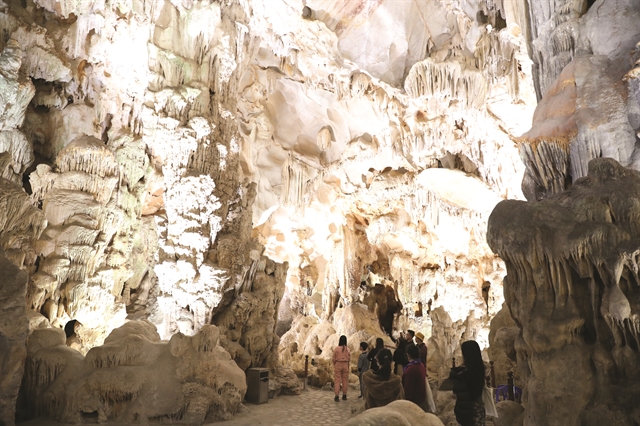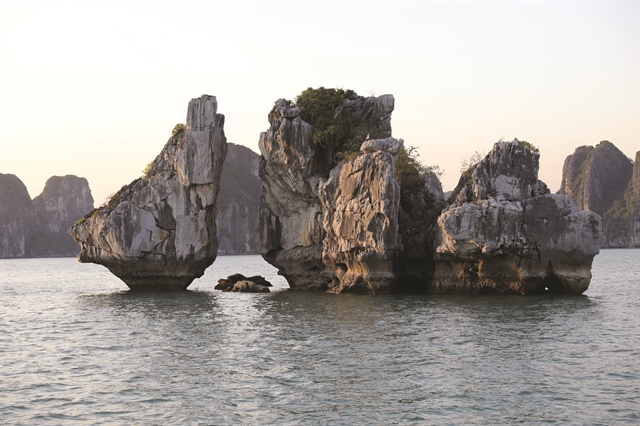
NATIONAL WONDER: Hạ Long Bay is one of Việt Nam's top travel destinations. VNS Photos Đoàn Tùng
By Nguyễn Mỹ Hà
The 45-km long seaside boulevard from Quảng Ninh City to Tuần Châu Island, where we were to take a boat ride on the bay was completely empty. Few cars were on the road during the one hour ride.
When we arrived at the Tuần Châu wharf, the usually full waiting room was almost empty. Only a few 'tourist scouts' were hanging around, trying to sell tickets to the bay tour during the day. There are only two tours: a 3- and a 5-hour day tour.
There are only two ports in Quảng Ninh where you can embark on a boat to tour Hạ Long Bay, one belongs to Sun Group and the other on Tuần Châu Island. Both are on private property, and you shall pay VNĐ40,000 for each ticket, discounted due to the pandemic.
Each tourist that pays the pass currently does not have to pay any landmark visiting fees, due to the pandemic. These days, boats lay idle at the port and it is quiet, the few tourists mostly going in a small group of close friends or family.
They all are reluctant to share a boat with strangers, so our team of five had to rent a beautiful well-furnished boat that could accommodate 48 people at a time, at a smashing price. For the same price, you could barely rent a small motorised boat in Nha Trang for four people.

JAW DROPPING: A trip to Hạ Long Bay includes visits to some of the bay's most spectacular caves.
"I'm a mechanic, I usually work at the back of the boat," explained a man onboard. He said prior to COVID-19, they all had to wear uniforms when serving tourists, but other staff had to rush to prepare dinner for guests on another boat, so he had been promoted to lead our tour.
The boat staff was down to a minimum, with a tour guide handling a few things on the boat and a mechanic or cook performing several different responsibilities.
To make everyone feel safe, the captain had to stay in his cabin.

RAISING THE BOATS: Floating punts add to diversity on Hạ Long Bay, where ancient floating villages such as Vung Viêng used to thrive.
Keeping boats afloat
Back in June at the first conference of Quảng Ninh Province People's Committee, it issued urgent decisions to waive tourist fees to Hạ Long Bay landmarks, Yên Tử pilgrimage site and Quảng Ninh Museum until the end of 2021. This decision was to relieve local businesses and boost the tourism industry, which was struggling for obvious reasons.
The Quảng Ninh Tourism Department reported that in the first half of the year, 2.5 million visitors toured the province, only 60 per cent of the same period in 2020, generating an income of VNĐ 5,250 billion (US$226 million).
The department also projected that if pandemic could be put under control, for the second half of year it hoped to receive more than 1 million visitors to Hạ Long Bay overnight, in which 150,000 visits were expected to come to Quảng Ninh Museum and 140,000 visit Yên Tử Landmark.
With visitor fees waived at all three major tourist destinations, the department expected a loss of VNĐ258 billion.
Earlier, a joint letter was signed by a representative of tourist boat owners appealing for the central government to help rescue them. "The COVID pandemic has pushed most of us overboard, we are on the verge of filing for bankruptcy," the letter read.
For the past two years, the Quảng Ninh tourism sector suffered heavily with ticket sales for Hạ Long Bay down by VNĐ1,000 billion and more than 5,000 people losing their jobs.

STAYING AFLOAT: White boats have become signature tourist boats on Hạ Long Bay, and some offer night stays on the bay.
Record low number of visitors
When we were on the bay last week, we couldn't have expected better weather; the sun was bright and there was a light breeze. The mild temperature made it close to the perfect tour experience.
There are two popular tours, the 3-hour that includes a two-cave visit, a ride to the Stone Dog, the Fighting Cocks, and the Incense Burner that is featured on the VNĐ200,000 note, as well as passing through Ba Hang floating village.
The 5-hour tour adds a stop for bathing at Titov Beach, which left a bad impression on us as there were too many boats at the wharf resulting in too many people, and we could see oil leaks on the water surface.
We chose the 3-hour ride. A guide was supposed to accompany us to the caves, but the woman who stayed with us on the boat assumed that as we were Vietnamese, we had been here many times and wouldn't need her guidance.
Such an attitude can lose visitors. No matter if we asked her to tell the cave story or not, it's her responsibility. This response can be seen at the peak of the season, where there are too many visitors and the guide becomes exhausted or in low season when there are so few tourists the guide just skips part of the job.
When we walked to the caves, the landscape ticket controller, Đoàn Anh Toàn, who has been on the job for 12 years, said he could remember the times when 17,000 tourists passed through his gate in a single day.
"Today, we had six boats, each had five to six people," he said. "They don't want to go in a big group, to distance from strangers."

STUFF OF LEGEND: Thousands of lime karst stones scattered on Hạ Long Bay are thought to be the remains of a dragon landing in the area.
Continued conservation work
The Hạ Long Bay Management Board was requested to report on the environmental impact of the area in 2006 due to economic development pressure. Later reports ensured Hạ Long Bay was awarded UNESCO World Natural Heritage status.
During the two years suffering from COVID, the management board continued its work on documenting scientific archives to preserve the natural values of Hạ Long Bay, increasing supervising economic-related activities around the bay area, and closely working with the International Union for Conservation of Nature and UNESCO for continued management and conservation work to protect the bay.
The final tourism statistics for 2021 have not been announced, but according to the deputy chief of the Hạ Long Management Board, the number is expected to be higher than 2020.
Quảng Ninh authorities, and the Hạ Long Bay management board on a smaller scale, have been strict to screen inbound and outbound travel in the province. Quảng Ninh has been careful to check any incoming visitors. QR codes for health declaration have been made available at every public venue or on private-own property that receives visitors.
When we arrived at Quảng Ninh Museum earlier that day, it was closed because one of its employees had tested positive for coronavirus. "We cannot give you an interview at this moment," the deputy director of the museum told Việt Nam News.
One of its employees, working in the back office, who spoke on condition of anonymity, told us that the museum had strengthened its procedure to have all visitors scanning QR codes, checking temperatures and sanitizing their hands. The COVID positive employee possibly got it from family, not visitors.
The Hạ Long Bay management board's double target for 2021 was to keep its staff and visitors protected from COVID, and continue conservation work and protect the bay from destructive intrusion.
"Maintain the province in safety and the growth rate in the new normal," reads the province resolution.
"Increasing the development growth rate and completing provincial economic, social infrastructure and speed up inter-provincial links for mutual benefit," is the annual assignment that the Quảng Ninh People's Committee is determined to accomplish.
All this should lay the foundation for the whole province to restart tourism, making Hạ Long Bay, Yên Tử Landmark and other destinations of Quảng Ninh safe and appealing to visit.
In a year when most of the world's borders were closed, the number of tourists fell, and air carriers shut down or cut flights, the World Travel Award 2021 awarded Quảng Ninh as Asia's Leading Tourist Attraction of 2021. VNS
OVietnam